1996 CADILLAC ELDORADO change wheel
[x] Cancel search: change wheelPage 197 of 354
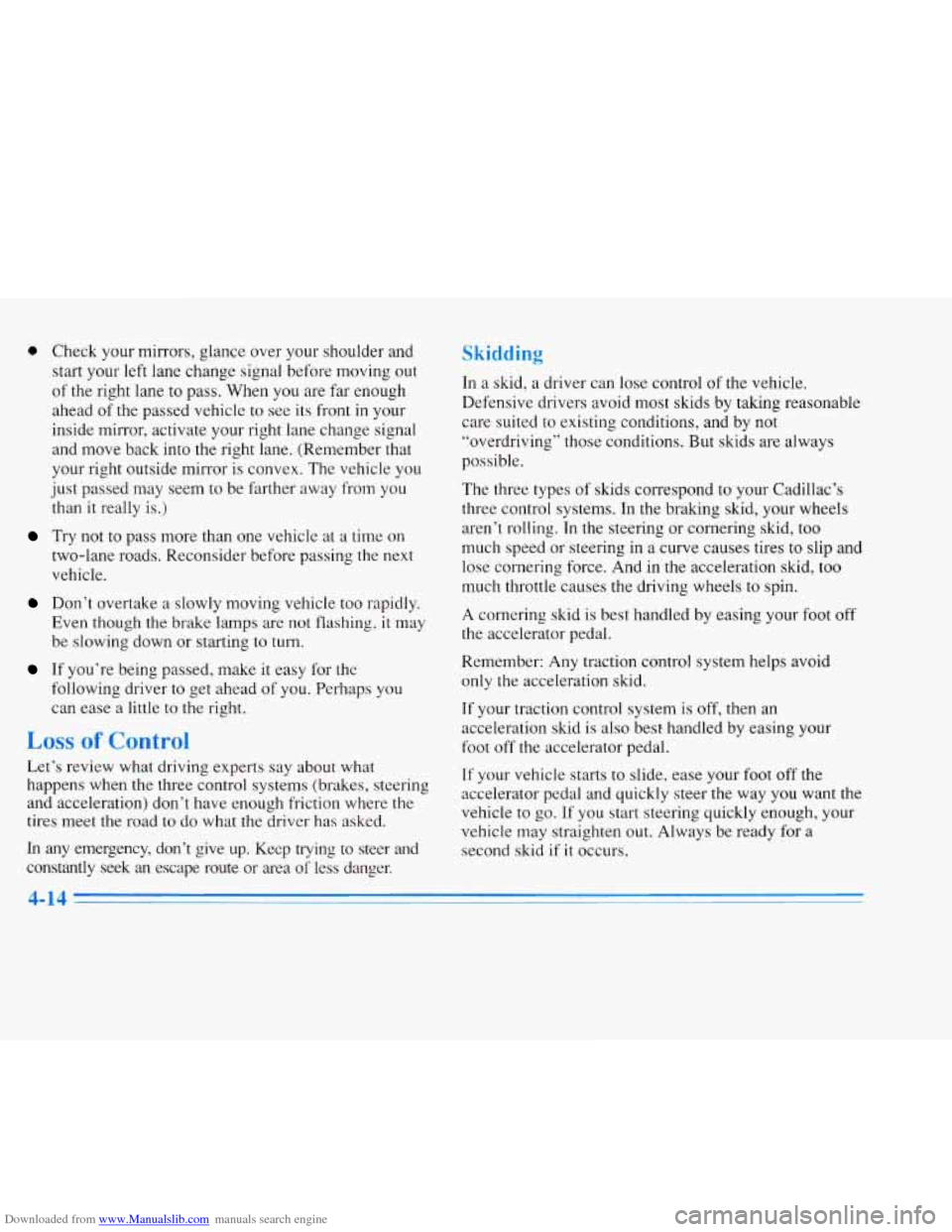
Downloaded from www.Manualslib.com manuals search engine 0 Check your mirrors, glance over your shoulder and start your left lane change signal before moving out
of the right lane to pass. When you are far enough
ahead of the passed vehicle to see its front
in your
inside mirror, activate your right lane change signal
and move back into the right lane. (Remember that
your right outside mirror is convex. The vehicle you
just passed may seem
to be farther away from you
than
it really is.)
Try not to pass more than one vehicle at a time on
two-lane roads. Reconsider before passing the next
vehicle.
Don’t overtake a slowly moving vehicle too rapidly.
Even though the brake lamps are not flashing, it may
be slowing down or starting to turn.
If you’re being passed, make it easy for the
following driver
to get ahead of you. Perhaps you
can ease a little to the right.
’C
s review wnat arlving experts say about what
happens when the three control systems (brakes, steering
and acceleration) don’t have enough friction where the
tires meet the road
to do what the driver has asked.
In any emergency, don’t give up. Keep trying to steer and
constantly seek an escape route or area
of less danger.
In a skid, a driver can lose control of the vehicle.
Defensive drivers avoid most skids by taking reasonable
care suited to existing conditions, and by not
“overdriving” those conditions. But skids are always
possible.
The
three types of skids correspond to your Cadillac’s
three control systems. In the braking skid, your wheels
aren’t rolling.
In the steering or cornering skid, too
much speed or steering
in a curve causes tires to slip and
lose cornering force. And in the acceleration skid, too
much throttle causes the driving wheels to spin.
A cornering skid is best handled by easing your foot off
the accelerator pedal.
Remember:
Any traction control system helps avoid
only the acceleration skid.
If your traction control system is
off, then an
acceleration skid is also best handled by easing your
foot off the accelerator pedal.
If your vehicle starts to slide, ease your foot off the
accelerator pedal and quickly steer the way you want the
vehicle to
go. If you start steering quickly enough, your
vehicle may straighten out. Always be ready
for a
second skid
if it occurs.
Page 215 of 354
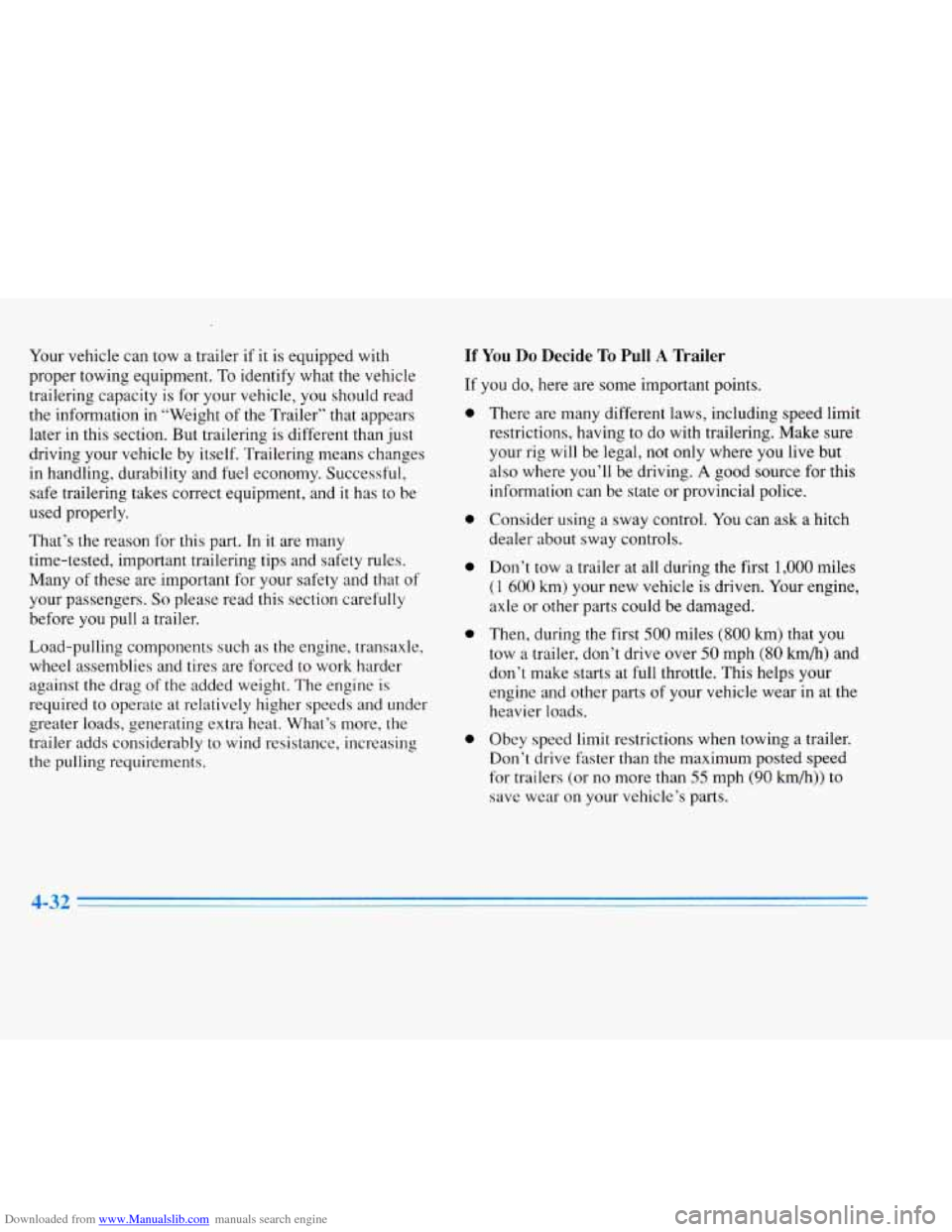
Downloaded from www.Manualslib.com manuals search engine Your vehicle can tow a trailer if it is equipped with
proper towing equipment. To identify what the vehicle
trailering capacity is for your vehicle, you should read
the information in “Weight of the Trailer” that appears
later in this section. But trailering is different than just
driving your vehicle by itself. Trailering means changes
in handling, durdbility and fuel economy. Successful,
safe trailering takes correct equipment, and
it has to be
used properly.
That’s the reason for this part. In
it are many
time-tested, important trailering tips and safety rules.
Many of these are important for your safety and that of
your passengers.
So please read this section carefully
before you pull a trailer.
Load-pulling components such as
the engine, transaxle,
wheel assemblies and tires are forced to work harder
against the drag of the added weight. The engine
is
required to operate at relatively higher speeds and under
greater loads, generating extra heat. What’s more, the
trailer adds considerably to wind resistance, increasing
the pulling requirements.
If You Do Decide To Pull A Trailer
If you do, here are some important points.
0
0
0
0
0
There are many different laws, including speed limit
restrictions, having
to do with trailering. Make sure
your rig will be legal, not only where you live but
also where you’ll be driving.
A good source for this
information can be state or provincial police.
Consider using a sway control.
You can ask a hitch
dealer about sway controls.
Don’t tow a trailer at all during the first
1,000 miles
(1 600 km) your new vehicle is driven. Your engine,
axle or other parts could be damaged.
Then, during the first
SO0 miles (800 km) that you
tow a trailer, don’t drive over
SO mph (80 h/h) and
don’t make starts at full throttle. This helps
your
engine and other parts of your vehicle wear in at the
heavier loads.
Obey speed limit restrictions when towing a trailer.
Don’t drive faste.r than the maximum posted speed
for trailers (or
no more than 55 mph (90 km/h)) to
save wear on your vehicle’s parts.
Page 229 of 354

Downloaded from www.Manualslib.com manuals search engine Towing Your Vehicle
Try to have a Cadillac dealer or a professional towing
service tow your Eldorado. See “Roadside Assistance”
in the Index.
If your vehicle has been changed or modified since it
was factory-new by adding aftermarket items like
fog
lamps, aero skirting or special tires and wheels, these
instructions may not be correct.
Before you
do anything, turn on the hazard
warning flashers.
When you call, tell the towing service:
0 That your vehicle has front-wheel drive.
The make, model and year of your vehicle.
Whether you can still move the shift lever.
If there was an accident, what was damaged.
When the towing service arrives, let the tow operator
know that this manual contains towing instructions and
illustrations. The operator may want to see them. Front Towing
5-8
Page 246 of 354
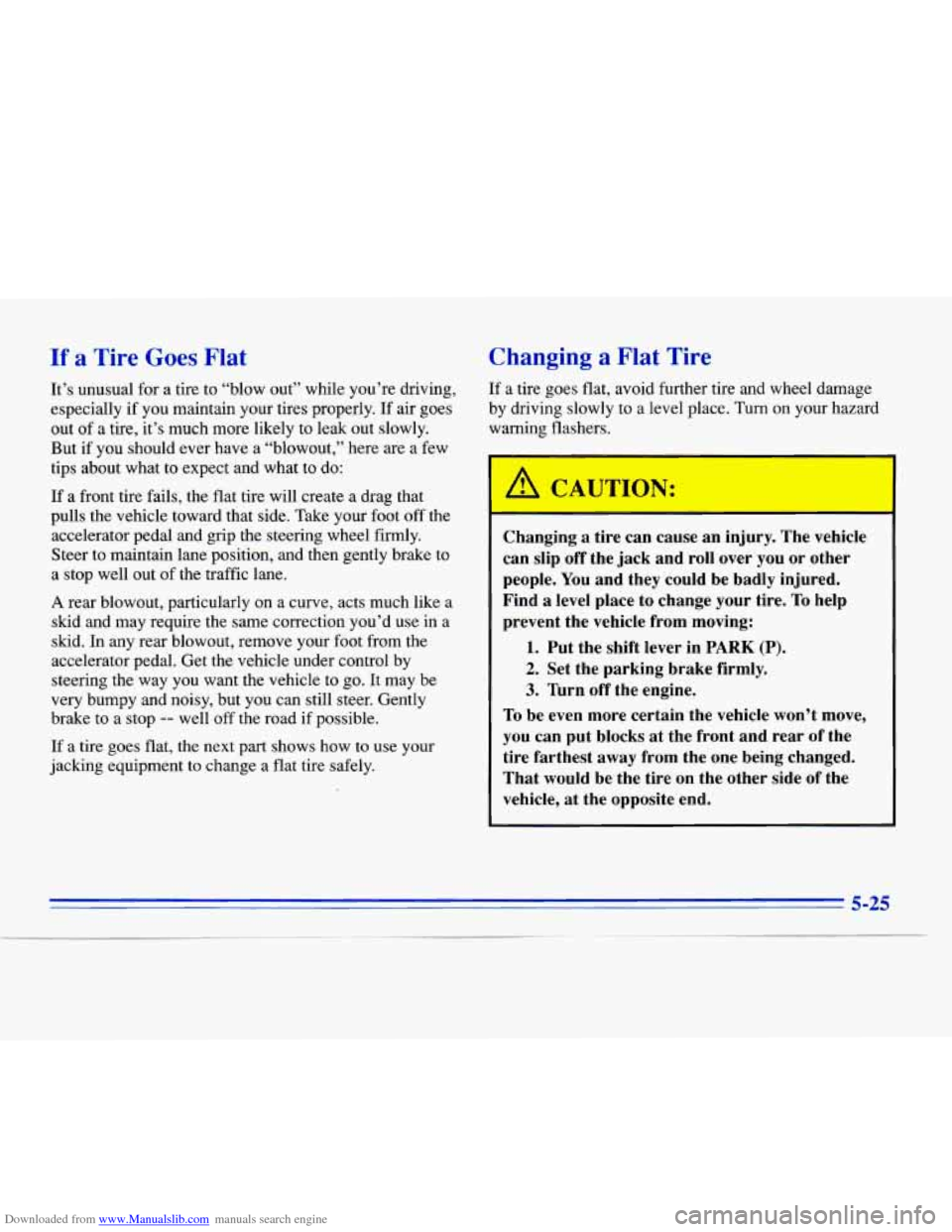
Downloaded from www.Manualslib.com manuals search engine If a Tire Goes Flat
It’s unusual for a tire to “blow out” while you’re driving,
especially if you maintain your tires properly. If air goes
out of a tire, it’s much more likely to leak out slowly.
But if you should ever have a “blowout,” here are
a few
tips about what to expect and what
to do:
If a front tire fails,
the flat tire will create a drag that
pulls the vehicle toward that side. Take your foot
off the
accelerator pedal and grip the steering wheel firmly.
Steer to maintain lane position, and then gently brake to
a stop well
out of the traffic lane.
A rear blowout, particularly on a curve, acts much like a
skid and may require the same correction you’d use in a
skid.
In any rear blowout, remove your foot from the
accelerator pedal. Get the vehicle under control by
steering the way
you want the vehicle to go. It may be
very bumpy and noisy, but you can still steer. Gently
brake to a stop
-- well off the road if possible.
If a tire goes flat, the next part shows how to use your
jacking equipment to change a flat tire safely.
Changing a Flat Tire
If a tire goes flat, avoid further tire and wheel damage
by driving slowly to a level place. Turn on your hazard
warning flashers.
A CAUTION:
Changing a tire can cause an injury. The vehicle
can slip
off the jack and roll over you or other
people.
You and they could be badly injured.
Find
a level place to change your tire. To help
prevent the vehicle from moving:
1. Put the shift lever in PARK (P).
2. Set the parking brake firmly.
3. ”urn off the engine.
To be even more certain the vehicle won’t move,
you can put blocks at the front and rear of the
tire farthest away from the one being changed.
That would be the tire on the other side
of the
vehicle, at the opposite end.
5-25
Page 252 of 354
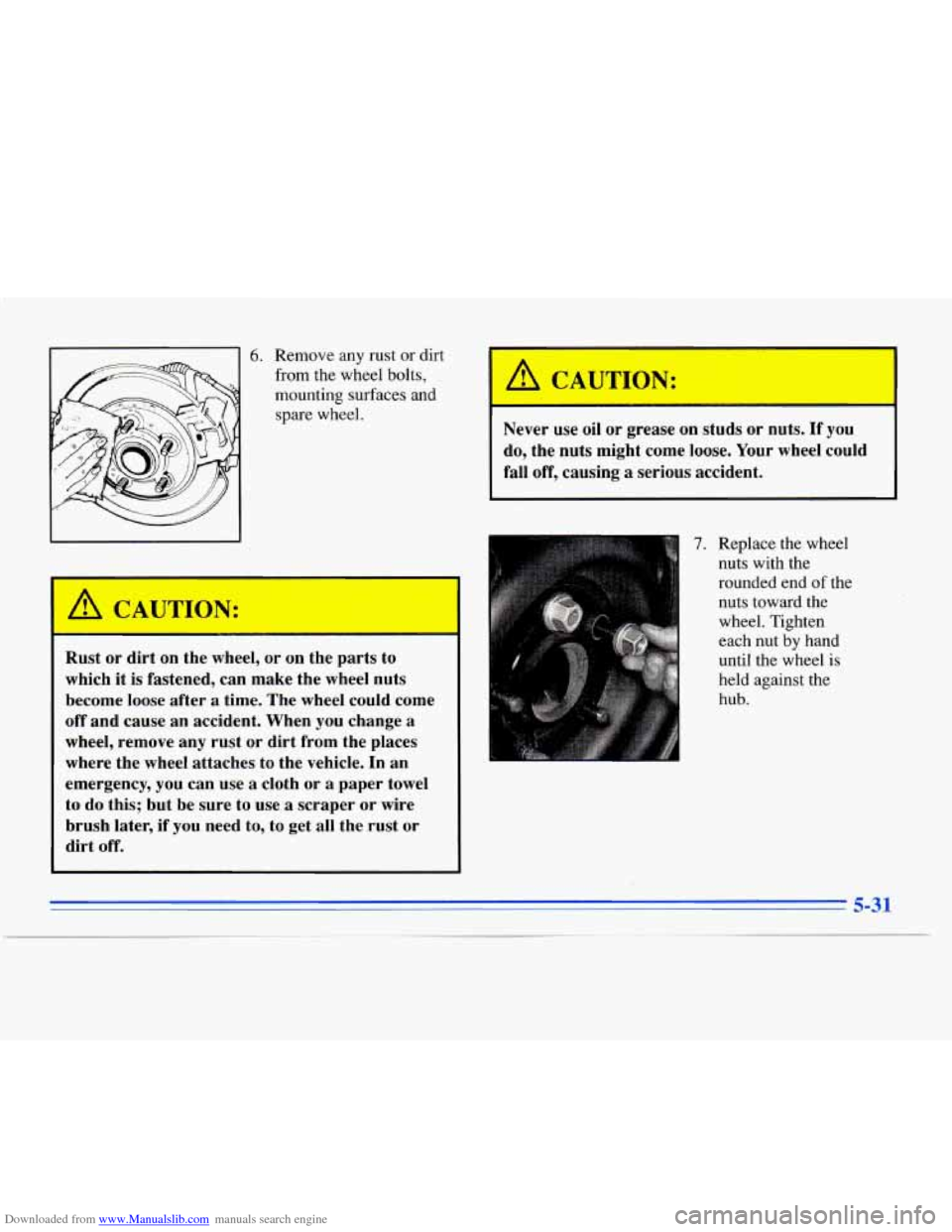
Downloaded from www.Manualslib.com manuals search engine 6. Remove any rust or dirt
from the wheel bolts,
mounting surfaces and spare wheel.
A CAUTION:
Rust or dirt on the wheel, or on the parts to
which it is fastened, can make the wheel nuts
become
loose after a time. The wheel could come
off and cause an accident. When you change a
wheel, remove any rust or dirt from the places
where the wheel attaches to the vehicle. In
an
emergency, you can use a cloth or a paper towel
to do this; but be sure to use
a scraper or wire
brush later, if you need
to, to get all the rust or
dirt off.
A CAUTION:
-
Never use oil or grease on studs or nuts. If you
do, the nuts might come loose. Your wheel could
fall off, causing
a serious accident.
7. Replace the wheel
nuts with the
rounded end
of the
nuts toward the wheel. Tighten
each nut
by hand
until the wheel
is
held against the
hub.
5-31
Page 298 of 354
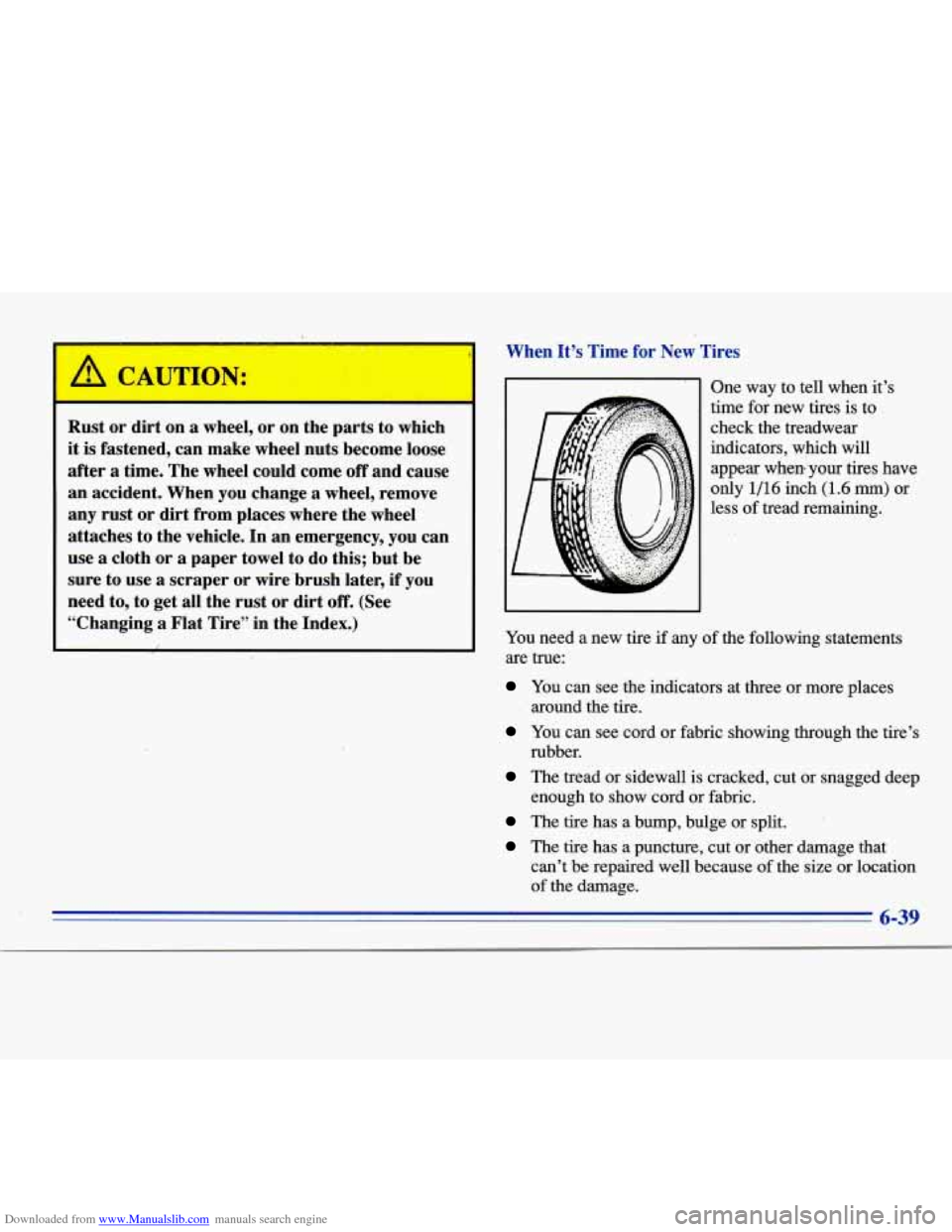
Downloaded from www.Manualslib.com manuals search engine I A CAUTION:
I
Rust or dirt on a wheel, or on the parts to which
it is fastened, can make wheel nuts become loose
after
a time. The wheel could come off and cause
an accident. When you change
a wheel, remove
any rust or dirt from places where the wheel
attaches to the vehicle. In an emergency,
you can
use
a cloth or a paper towel to do this; but be
sure to use a scraper or wire brush later, if you
need to, to get
all the rust or dirt off. (See
“Changing
a Flat Tire” in the Index.)
,
When It’s Time for New Tires
One way to tell when it’s
time for new tires is to check the treadwear
indicators, which
will
appear whenb’,your tires have
only
1/16 inch (1.6 mm) or
less of tread remaining.
You need a new tire if any of the following statements
are true:
You can see the indicators at three or more places
around the tire.
You can see cord or fabric showing through the tire’s
rubber.
The tread or sidewall is cracked, cut or snagged deep enough to show cord or fabric.
The tire has a bump, bulge or split.
The tire has a puncture, cut or other damage that can’t be repaired well because of the size or location
of the damage.
6-39
Page 324 of 354

Downloaded from www.Manualslib.com manuals search engine Capacities and
Capacities
Transaxle (4T80-E)
Specifications (Continued)
........................................ 15quarts
Crankcase (Engine Oil with Filter Change)
..................... 7.5 quarts
Engine Cooling System
.................................... 12.5 quarts
Fuel Tank
............................................ rr ‘i 20 gallons
R- 134a Refrigerant
......................................... .2.0 lbs.
Wheel Base
............................................. 108 inches
Length
............................................... 200.2inches
Height
................................................ 53.6 inches
Width
................................................. 75.5inches
Front Tread
............................................ 60.9 inches
Rear Tread
............................................. 60.9-inches
WheelNutTorque ......................................... 1OOlb-ft
Vehicle Dimensions
(14.2 L)
(7.1 L)
(11.8 L)
(75.7 L)
(0.91
kg)
(2 743 mm)
(5 086
mm)
(1 361.5 mm)
(1 918.4 mm)
(1 546 mm)
(1 546 mm) (140 N-m)
6-65
I
Page 343 of 354
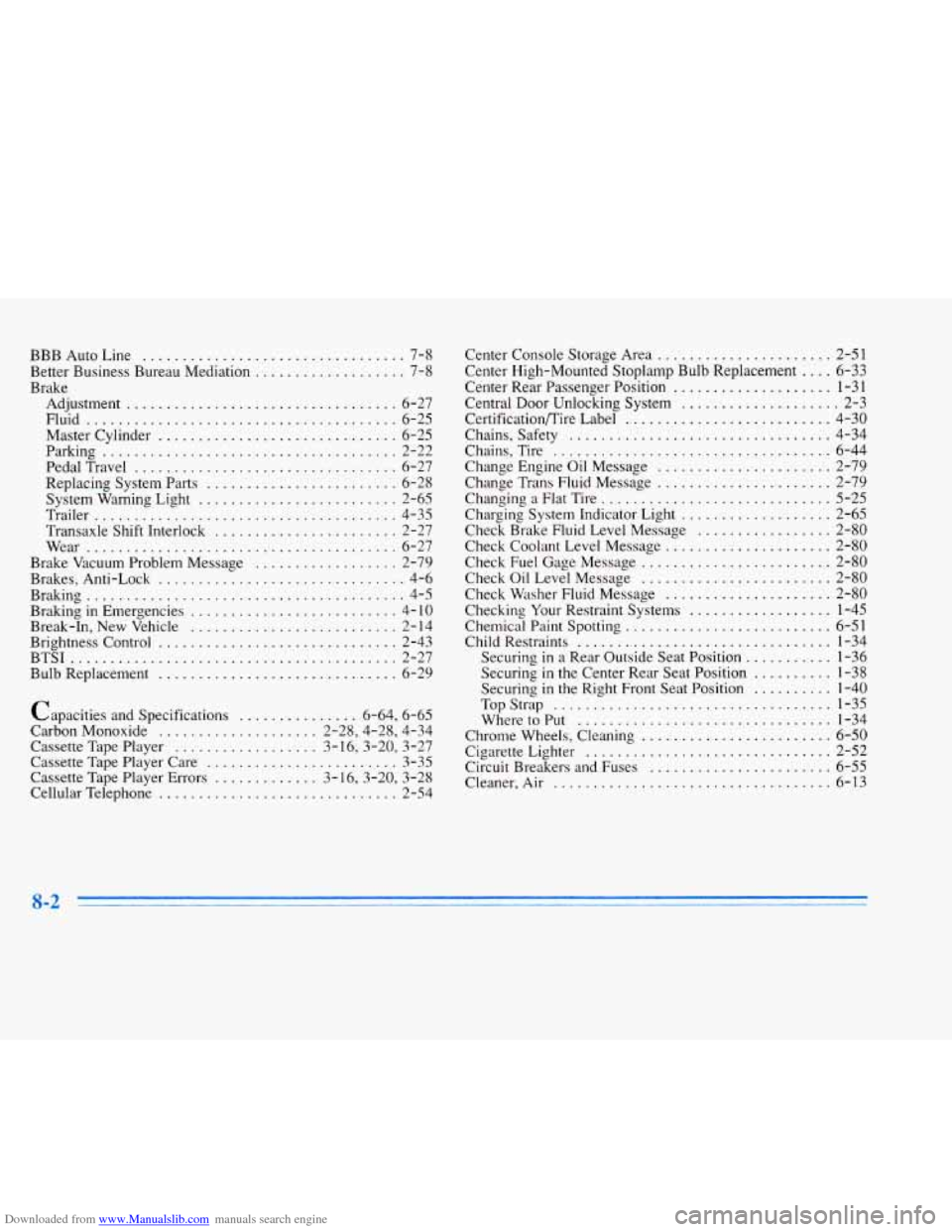
Downloaded from www.Manualslib.com manuals search engine BBB Auto Line ................................. 7-8
Better Business Bureau Mediation
................... 7-8
Brake Adjustment
.................................. 6-27
Fluid
....................................... 6-25
Master Cylinder
.............................. 6-25
Parking
..................................... 2-22
PedalTravel
................................. 6-27
Replacing System Parts
........................ 6-28
System Warning Light
......................... 2-65
Trailer
...................................... 4-35
Transaxle Shift Interlock
....................... 2-27
Wear
....................................... 6-27
Brake Vacuum Problem Message
.................. 2-79
Brakes. Anti-Lock
............................... 4-6
Braking
........................................ 4-5
Braking
in Emergencies .......................... 4- 10
Break-In. New Vehicle .......................... 2- 14
Brightness Control
.............................. 2-43
Bulb Replacement
.............................. 6-29
BTSI
......................................... 2-27
Capacities and Specifications
............... 6.64. 6.65
Carbon Monoxide
.................... 2.28.4.28. 4.34
Cassette Tape Player
.................. 3.16.3.20. 3.27
Cassette Tape Player Care
........................ 3-35
Cassette Tape Player Errors
............. 3.16. 3.20. 3.28
Cellular Telephone
.............................. 2-54 Center Console
Storage Area
...................... 2-51
Center High-Mounted Stoplamp Bulb Replacement
.... 6-33
Center Rear Passenger Position
.................... 1-31
Certificationnire Label
.......................... 4-30
Chains. Safety
................................. 4-34
Chains. Tire
................................... 6-44
Change Engine Oil Message
...................... 2-79
Changing a Flat Tire
............................. 5-25
Chargmg System Indicator Light
................... 2-65
Check Brake Fluid Level Message
................. 2-80
Check Coolant Level Message
..................... 2-80
Check Fuel Gage Message
........................ 2-80
Check Oil Level Message
........................ 2-80
Check %&her Fluid Message
..................... 2-80
Checking Your Restraint Systems
.................. 1-45
Chemical Paint Spotting
.......................... 6-51
Child Restraints
................................ 1-34
Securing in
a Rear Outside Seat Position ........... 1-36
Securing
in the Center Rear Seat Position .......... 1-38
Securing
in the Right Front Seat Position .......... 1-40
TopStrap
................................... 1-35
WheretoPut ................................ 1-34
Chrome Wheels. Cleaning
........................ 6-50
Circuit Breakers and Fuses
....................... 6-55
Cleaner. Air
................................... 6-13
Central Door Unlocking System
.................... 2-3
Change Trans Fluid Message
...................... 2-79
Cigarette Lighter
............................... 2-52